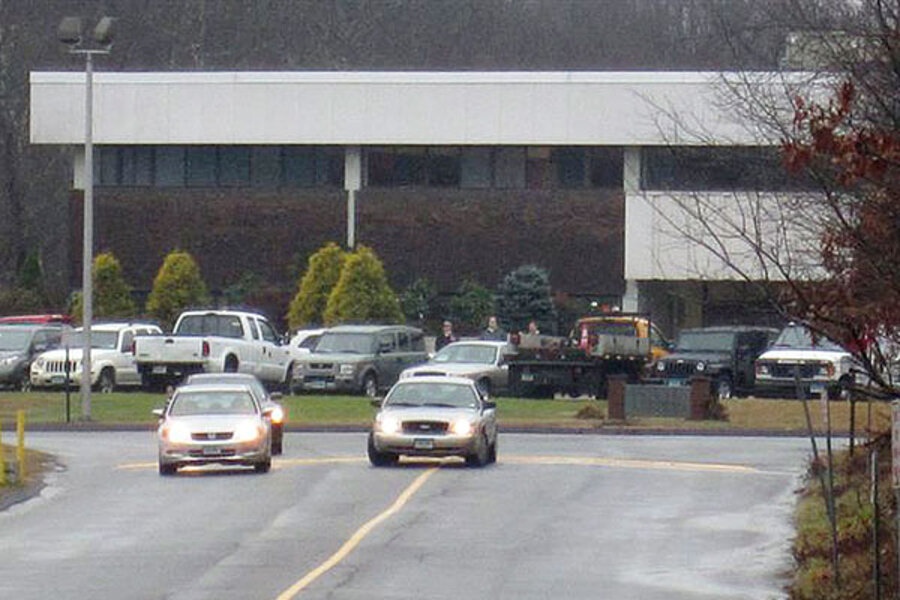New school, new routines: what awaits Sandy Hook students Thursday
School starts again at 9:07 Thursday morning for the students of Sandy Hook Elementary.
Going back to school won’t be the same as getting back to normal. But connecting students to their friends, teachers, and other caring adults can go a long way toward helping them recover from the traumatic mass shooting they survived on Dec. 14, experts say.
“They need to get back and see their peers,” says David Schonfeld, director of the National Center for School Crisis and Bereavement in Cincinnati. “Particularly for young children, they may not really know or fully accept who is alive if they don’t see them…. [And] getting back to school is another opportunity for them to express how they’re feeling and get some assistance in coping.”
The school building – a repurposed former middle school in nearby Monroe, Conn. – is different. But staff and volunteers have made every effort to create a familiar environment – even setting up desks and pictures to match what students left behind.
Sandy Hook teachers decided “the familiar surroundings would be more a comfort than an emotional trigger,” says Eric Excell-Bailey, a spokesman for the American Federation of Teachers in Connecticut.
Children may be apprehensive about starting back, especially at a new school, but “continuity is very important,” says Julian Ford, a psychiatry professor at the University of Connecticut who has been advising pediatricians and mental-health providers in the Newtown area. “Kids pick up on very small details. They can be very reassuring without anyone having to say a lot at all,” he says.
On Wednesday, families coming to tour the building during an open house were welcomed with signs along the road offering such messages as, “Welcome. You are in our prayers.”
In the building, students are also being welcomed with painted handprints from Connecticut schoolchildren and snowflakes made by students from around the country, Mr. Excell-Bailey says.
“We want to get back to teaching and learning,” said Newtown superintendent Janet Robinson. “We will obviously take time out from the academics for any conversations that need to take place, and there will be a lot of support there.”
Grief counselors and police are on hand to reassure both staff and students.
A parent or guardian is also welcome to stay with or nearby a child on the first days if needed, said interim principal Donna Page in a note on the school district’s website.
If parents are apprehensive about sending their child back to school, the best thing they can do is check in regularly with a caring friend or family member to share their feelings, Professor Ford says. “When they have that sense of being cared for, they are much more confident and able to send their kids off to school with message of, ‘This is a good thing, and any way I can help you, I will.’ ”
When Dr. Schonfeld of the National Center for School Crisis and Bereavement met with teachers a few days after the shooting, he recommended some steps to plan for students to return to school. For one, he said, adjust academic expectations to account for the fact that both students and teachers may have difficulty fully concentrating. Make a safe environment for kids to say if they had trouble with homework because they had nightmares, for instance, and “academic growth will come later.”
“The goal is not for teachers to conduct therapy, but to be supportive,” Schonfeld says.
Often what’s most helpful for children, says Ford, is if teachers “provide the usual structure for learning and creative arts that will allow kids to express their questions.”
The school district can support staff by having substitute teachers on hand to step in if a teacher needs a break to speak with a counselor or just regain composure, Schonfeld suggests.
Very few teachers were absent when the other Newtown schools reopened just five days after the shootings, says Excell-Bailey. But three to four weeks after such a crisis is often when survivors need the most help, he says. “Nobody would think of making [teachers] feel guilty if they’re not ready” to return full time to Sandy Hook, he says.
While much of the focus is on helping survivors get back to normal routines, the students and staff lost in the tragedy are not far from anyone’s minds.
Principal Page, who came out of retirement to lead the school once again, noted to families of victims in her letter that those “loved ones are foremost in our hearts and minds as we move forward…. Your strength and compassion has been and will continue to be an inspiration to me and countless others as we work to honor the memory of your precious children and our beloved staff.”
A coalition of education leaders created a website to match donations with specific projects that teachers are planning in Newtown. “As we grieve and continue the work of supporting one another during this difficult time, we are grateful for these contributions that will help our teachers create … enriching and caring environments for their students,” noted Tom Kuroski, president of the Newtown Federation of Teachers, in a late-December press release.
Preparations are also under way for the long-term supports that may be needed. Teachers around Connecticut are being trained in counseling skills to help their peers, for instance.
For some staff and students, it may take months or years to do things at the level they previously did, and some may experience long-term problems, Schonfeld says.
Others, he says, may experience “post-traumatic growth” – becoming more resilient, for instance, or developing new career goals or a deeper sense of spirituality.
“People are changed forever by these experiences,” Schonfeld says. “It does not mean that they are damaged forever. They’re just different.”
• Associated Press material was used in this report






